#iOS App Scraping
Explore tagged Tumblr posts
Text
Mobile App Scraping Services - Extract Android and IOS App Data
Gather accurate data from any iOS & Android apps using Our mobile app scraping service to make informed business decisions.
Know More : https://www.crawlxpert.com/mobile-app-scraping-services-extract-android-and-ios-app-data
#Mobile App Scraping Services#Extract Android and IOS App Data#ScrapedatafromiOSandAndroidapps#AndroidandIOSAppDataScraper
0 notes
Text
Mobile App Scraping Services | Extract Android & iOS Apps Data.
Unlock valuable insights with our Mobile App Scraping Services in the USA, UAE, UK, Canada, Spain, France, and India. Extract data from Android & iOS apps today.
know more: https://www.mobileappscraping.com/
#Mobile App Scraping Services#Android Apps Data Scraping#Scrape iOS Apps Data#Androis App Scraper#iOS App Scraper
1 note
·
View note
Text





TofuPixel Links + FAQ - Commissions Open!
🌟 Building a game: @wishlings 🌠
🎨 My Portfolio
Support me: 💜 Tip Me 💜 Digital Store 💜 Print Store 💜 Game Assets 💜 Stickers + Merch
Socials: Bluesky | Cara | GameJolt | TikTok
Yes you can use / cross-stitch my work for personal use! <3
🎨 Pixel Art Beginner Guide
Hello, I'm Tofu, a pixel artist based in England. I work full-time doing pixel illustrations or game-art. I started learning in my early 20s, so no it's not too late for you!
I run a 7k+ member Discord server called Cafe Dot, where we host events like gesture drawing and portrait club.
I currently have Good Omens brainrot so expect some fanart on this blog. I also occasionally do/reblog horror art so be mindful of that!
Due to so much AI nonsense on every platform, all my public work will be filtered/edited with anti-AI scraping techniques. Supporters on my Ko-Fi can see unfiltered work and also download it.
🌸 Want to learn how to do pixel art? Check my tutorial tag!
Other tags:
tutorial (not pixel specific)
my art
follow (artists i recommend)
🌟Free Stuff!!!
❔FAQ
What app do you use? I use Aseprite on PC and occasionally Pixquare on iOS (use code tofu for 30% off Pixquare!! <3) Free alternative: Libresprite on PC
Why does your art look so crunchy / compressed? Glaze
How did you learn pixel art? I first started out watching MortMort and making tiny sprites. Then once I started getting interested in landscapes/environment art, I did many, many Studio Ghibli studies.
How can I also protect my art? You can use Glaze and Nightshade- Glaze protects against Img2Img style copying, and Nightshade poisons the data so the AI thinks it's the opposite of what it actually is. There is a lot of misinformation going around (likely from pro-AI groups) so do your own research too! If you're a pixel artist you can also tilt or blur your art after upscaling, which will make it near useless to AI models (or regular thieves) once downscaled again.
Feel free to send me an ask if there's anything you want to know! I am always happy to help beginners :--3
1K notes
·
View notes
Text
People should really consider using Tumblr mobile web instead of the app. It means your Tumblr account isn't directly beholden to app store companies, ie Apple and Google, so it hasn't experienced the automatic user settings changes to suppress mature content that ios and android users have both now experienced.
You're also taking your business away from app stores by using mobile web, especially if you pay for a tumblr subscription via an app store (I mean, idk who does lol but just saying). You'd still be using a browser app of course but you can choose which browser fits your needs & privacy level preferences (including choosing not to use Chrome), and deleting the Tumblr app is one less app downloaded, one less app scraping your personal information. It obviously doesn't impact what content is labeled as mature, but it's a drop in the bucket as far as making your Tumblr account one extra step removed from app store control.
Mobile web is the neglected stepchild of Tumblr updates, too, and that's a great thing lmao. The updates we do get are the ones that are more solid quality-of-life improvements and better tested before they get released, in my experience anyway.
Mobile web usually doesn't get all the flashy new updates right away or frequent UI changes that the apps get (I hate that kind of stuff so it's a plus for me lol), I find the UI much more straightforward and simple from my brief flings with the app, and experiences less bugginess from what I read on the @/changes official account.
So, app store is making it more difficult to access adult content? Don't use the app!
118 notes
·
View notes
Text
Frank Wilhoit described conservativism as “exactly one proposition”:
There must be in-groups whom the law protects but does not bind, alongside out-groups whom the law binds but does not protect.This is likewise the project of corporatism. Tech platforms are urgently committed to ensuring that they can do anything they want on their platforms — and they’re even more dedicated to the proposition that you must not do anything they don’t want on their platforms.
They can lock you in. You can’t unlock yourself. Facebook attained network-effects growth by giving its users bots that logged into Myspace on their behalf, scraped the contents of their inboxes for the messages from the friends they left behind, and plunked them in their Facebook inboxes.
Facebook then sued a company that did the same thing to Facebook, who wanted to make it as easy for Facebook users to leave Facebook as it had been to get started there.
Apple reverse-engineered Microsoft’s crown jewels — the Office file-formats that kept users locked to its operating systems — so it could clone them and let users change OSes.
Try to do that today — say, to make a runtime so you can use your iOS apps and media on an Android device or a non-Apple desktop — and Apple will reduce you to radioactive rubble.
- Let the Platforms Burn: The Opposite of Good Fires is Wildfires
#platform decay#fire debt#good fire#threads#interoperability#privacy without monopoly#fediverse#zuck's empire of oily rags#wildland–urban interface#network effects#switching costs#network effects vs switching costs#adversarial interoperability#comcom#competitive compatibility#enshittification#twiddling
866 notes
·
View notes
Text
Infinity Nikki 1.4 vs 1.5 Revenue Based On Sensor Tower reports

2025 May Revenue—April 30 to May 30 Infinity Nikki 1.5: CN¥ 72,193,486 | US$ 10,055,153.20

2025 April Revenue—March 31 to April 29 Infinity Nikki 1.4: CN¥64,143,573 | US$ 8,933,956.36
According to these reports, Infinity Nikki's revenue is up 12% month-over-month. However, compared to March, May’s revenue is down by 54%. On a positive note, May is the first month since the launch in December to show month-over-month revenue growth.
Disclaimer: Revenue figures presented here are estimates based on Sensor Tower data, which integrate: 1. Publicly scraped data from the Apple App Store and Google Play Store. 2. Anonymised analytics via Sensor Tower’s proprietary panel of apps on both iOS and Android modelled through algorithms and machine learning. 3. Does not account for PC and PlayStation platforms revenue. These estimates are not official publisher numbers and may differ from actual values.
Data Cr: 赛博蛋挞9527 CN¥ to US$ Conversion is based on June 17, 8:00 am UTC Google Conversion Rate.
#this likely reflects a degree of dissatisfaction among paying players during Infinity Nikki version 1.5.#infinity nikki#nikki cn
2 notes
·
View notes
Note
Hii, how do I get that page layout(like you have on your writing, the enclosure),which app? And also love your soul poetry and writings!
hello friend !!
i personally use apple's pages app to do the formatting of my poetry (and recently, the fragments i share), but any word processor app like google docs or word should work just fine !
i just like pages for how i can edit documents both on mobile and desktop, its ui, and its font choices (which are just the standard ios fonts; i think zoho has a bigger list of fonts out of the apps i've tried); i also just want to use something that isn't owned by google or microsoft and didn't make me feel like my poetry was getting scraped for feeding into llms (which i'm sure they do anyway :/ which in case i'd go with zoho)
but yes ! i like pages ! on both desktop and mobile, there are just small things that make it much smoother to use than google docs or word (like two-page view, to name one thing !!!!!!!! it's so much easier to visualize how writing projects will be read seeing it two pages at a time)
thank you for taking the time to read my work ! your presence is so deeply appreciated ;w; ♥️
#?#rant over lmao#though there are other things i can say i really like about pages#i don't wanna get too off track shdjf
3 notes
·
View notes
Text
Guys, if you just updated your IOS software on your i-phone. Apple is now using AI to scrape data from your apps. Siri is now considered an A.I. Luckily, we can turn it off!
Go to Settings.
Click on Siri.
Click on apps.
Click on each individual app. There should be a button that says “learn from this App”.
Tap on that button to turn it from green to white and you should be good.
Hope this helps. Husband just saw this on imgur.
2 notes
·
View notes
Text

Don't @ me for my paranoia but the most recent iOS update put this app on my Home Screen, and I truly authentically believe Apple wants me to journal in it so it can scrape the data and sell me products.
10 notes
·
View notes
Text
Syncing Scrivener 3 with Mega
Because Dropbox is dumb and being very glitchy lately, the sync function is no longer reliable. I spent a day trying to figure out why it wasn't syncing only to find out this is now an issue among Android and iOS users alike. Given the piddly space Dropbox gives as well as these ongoing issues, I decided to jump ship. If have Scrivener and are thinking of doing the same, here's a lil guide for you.
I opted to go with Mega. Their free account comes with 20 GB. Their website says 20, but if you download the mobile and desktop app, you get a 5 GB bonus for each. I suspect it might not be a permanent bonus, likely for a year, but I'll check again in the summer of 2025. They are also more privacy-oriented and have no AI scraping (like Google).
This walkthrough is for Android. I'd imagine the steps are similar for iOS, but I can't say for sure.
1. Make a Mega account, go through all that registration stuff.
2. Download the mobile app. Log in.
3. Download the desktop app. Log in
4. Open File Explorer and make a folder wherever you'd like your files to be synced from.
5. Once the desktop app is installed, you need to look for the icon to open the program. I found it in my task bar. The little red M icon is what you need to open.

6. Go to the three dots and double click to open up options.

7. Go to settings.
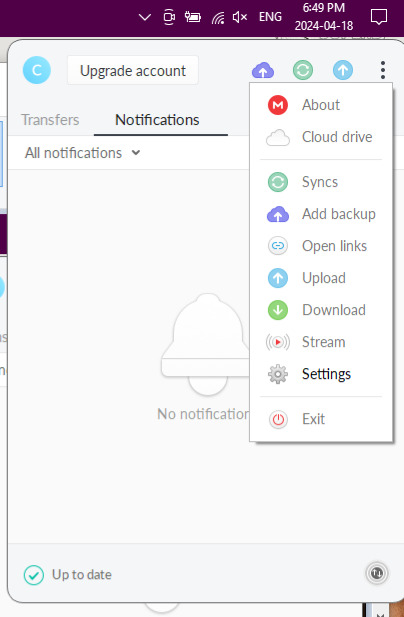
8. Go to the Sync option in the Settings menu. Select Add.

9. Another dialogue box will pop up. One the 'Local Folder' line, click 'Add'.
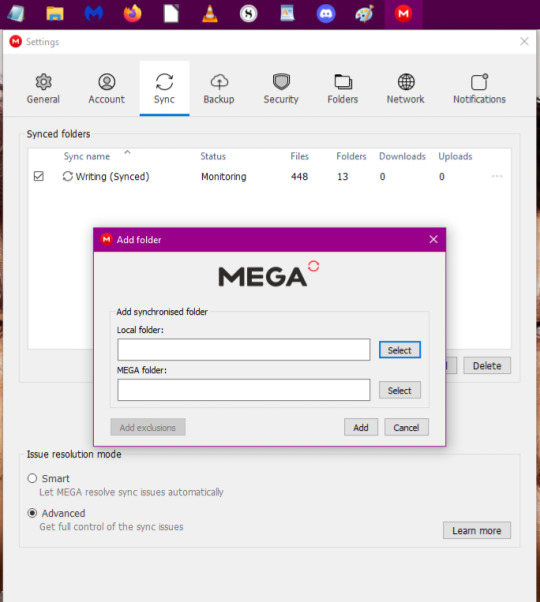
10. Select the folder you made specifically for sync. For this walkthrough, I'm using the 'Testing' folder.

11. Once you've selected your folder, you'll be back at the previous dialogue box. Now click on 'Select' on the MEGA folder line.

12. I forgot to take a screenshot, but you'll have a new dialogue box pop up with an empty list. Select the grey box saying 'New Folder'. You can name it whatever you want but I gave it the name 'Test'. Once done, your screen should look similar to the one below. Then click 'OK'.
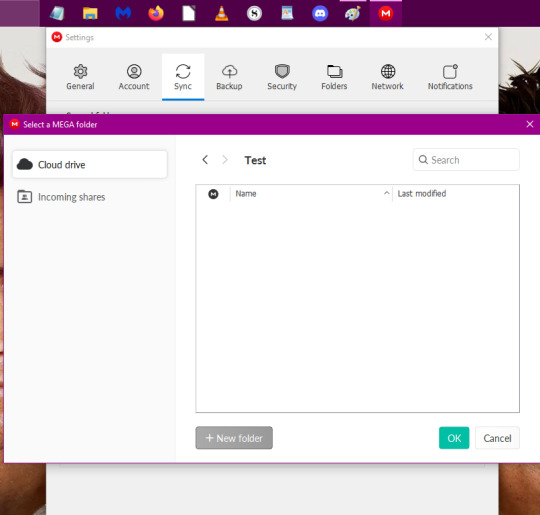
13. When done, your dialogue box should look like below. This is the crucial step as this is how the Mega program will help you sync with Scrivener. Make sure these folders are exactly where you want them to be and are named as you want. Once you're certain, click 'Add'
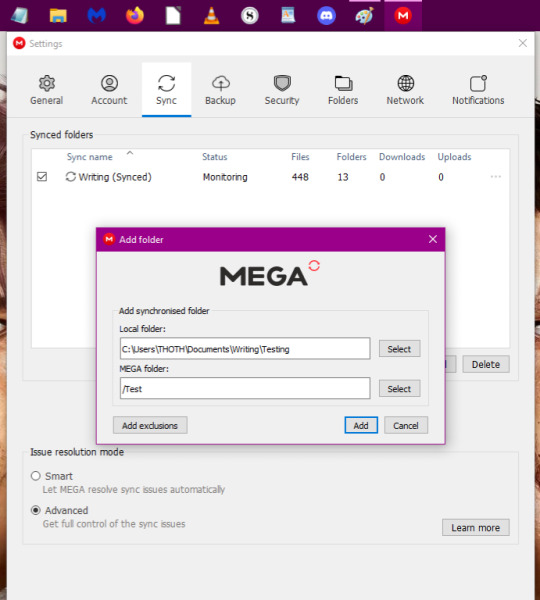
14. When done, you'll have a list that looks similar to this. The first step is done.
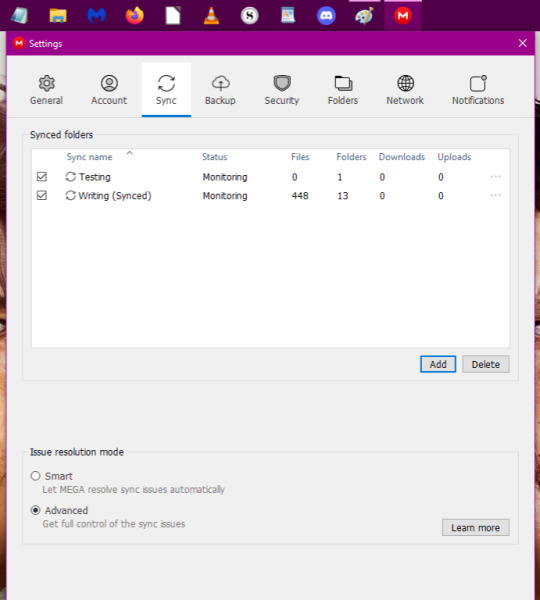
6 notes
·
View notes
Text
Mobile App Scraping Services for iOS and Android | Maximize Your Business Potential
Unlock the full potential of your business with our Mobile App Scraping Services for iOS and Android. Harness valuable insights and data to drive growth and success.
0 notes
Text
Exploring the Expansive Horizon of Selenium in Software Testing and Automation
In the dynamic and ever-transforming realm of software testing and automation, Selenium stands as an invincible powerhouse, continually evolving and expanding its horizons. Beyond being a mere tool, Selenium has matured into a comprehensive and multifaceted framework, solidifying its position as the industry's touchstone for web application testing. Its pervasive influence and indispensable role in the landscape of software quality assurance cannot be overstated.

Selenium's journey from a simple automation tool to a complex ecosystem has been nothing short of remarkable. With each new iteration and enhancement, it has consistently adapted to meet the evolving needs of software developers and testers worldwide. Its adaptability and extensibility have enabled it to stay ahead of the curve in a field where change is the only constant. In this blog, we embark on a thorough exploration of Selenium's expansive capabilities, shedding light on its multifaceted nature and its indispensable position within the constantly shifting landscape of software testing and quality assurance.
1. Web Application Testing: Selenium's claim to fame lies in its prowess in automating web testing. As web applications proliferate, the demand for skilled Selenium professionals escalates. Selenium's ability to conduct functional and regression testing makes it the preferred choice for ensuring the quality and reliability of web applications, a domain where excellence is non-negotiable.
2. Cross-Browser Testing: In a world of diverse web browsers, compatibility is paramount. Selenium's cross-browser testing capabilities are instrumental in validating that web applications perform seamlessly across Chrome, Firefox, Safari, Edge, and more. It ensures a consistent and user-friendly experience, regardless of the chosen browser.
3. Mobile Application Testing: Selenium's reach extends to mobile app testing through the integration of Appium, a mobile automation tool. This expansion widens the scope of Selenium to encompass the mobile application domain, enabling testers to automate testing across iOS and Android platforms with the same dexterity.
4. Integration with Continuous Integration (CI) and Continuous Delivery (CD): Selenium seamlessly integrates into CI/CD pipelines, a pivotal component of modern software development. Automated tests are executed automatically upon code changes, providing swift feedback to development teams and safeguarding against the introduction of defects.
5. Data-Driven Testing: Selenium empowers testers with data-driven testing capabilities. Testers can execute the same test with multiple sets of data, facilitating comprehensive assessment of application performance under various scenarios. This approach enhances test coverage and identifies potential issues more effectively.
6. Parallel Testing: The ability to run tests in parallel is a game-changer, particularly in Agile and DevOps environments where rapid feedback is paramount. Selenium's parallel testing capability accelerates the testing process, ensuring that it does not become a bottleneck in the development pipeline.
7. Web Scraping: Selenium's utility extends beyond testing; it can be harnessed for web scraping. This versatility allows users to extract data from websites for diverse purposes, including data analysis, market research, and competitive intelligence.
8. Robotic Process Automation: Selenium transcends testing and enters the realm of Robotic Process Automation (RPA). It can be employed to automate repetitive and rule-based tasks on web applications, streamlining processes, and reducing manual effort.
9. Community and Support: Selenium boasts an active and vibrant community of developers and testers. This community actively contributes to Selenium's growth, ensuring that it remains up-to-date with emerging technologies and industry trends. This collective effort further broadens Selenium's scope.
10. Career Opportunities: With the widespread adoption of Selenium in the software industry, there is a burgeoning demand for Selenium professionals. Mastery of Selenium opens doors to a plethora of career opportunities in software testing, automation, and quality assurance.
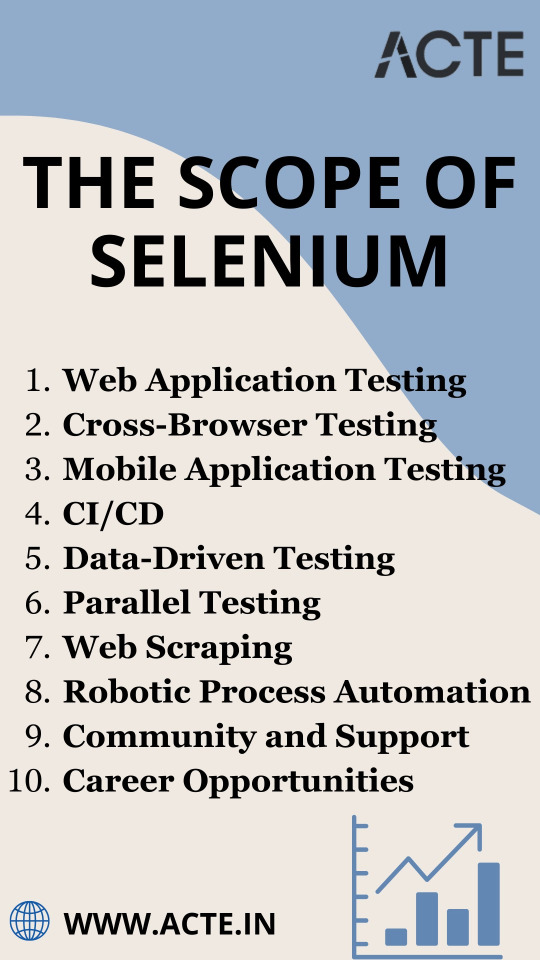
In conclusion, Selenium's scope is expansive and continuously evolving, encompassing web and mobile application testing, CI/CD integration, data-driven testing, web scraping, RPA, and more. To harness the full potential of Selenium and thrive in the dynamic field of software quality assurance, consider enrolling in training and certification programs. ACTE Technologies, a renowned institution, offers comprehensive Selenium training and certification courses. Their seasoned instructors and industry-focused curriculum are designed to equip you with the skills and knowledge needed to excel in Selenium testing and automation. Explore ACTE Technologies to elevate your Selenium skills and stay at the forefront of the software testing and automation domain, where excellence is the ultimate benchmark of success.
3 notes
·
View notes
Text
What happened to the cycle of renewal? Where are the regular, controlled burns?
Like the California settlers who subjugated the First Nations people and declared war on good fire, the finance sector conquered the tech sector.
It started in the 1980s, the era of personal computers — and Reaganomics. A new economic and legal orthodoxy took hold, one that celebrated monopolies as “efficient,” and counseled governments to nurture and protect corporations as they grew both too big to fail, and too big to jail.
For 40 years, we’ve been steadily reducing antitrust enforcement. That means a company like Google can create a single great product (a search engine) and use investors’ cash to buy a mobile stack, a video stack, an ad stack, a server-management stack, a collaboration stack, a maps and navigation stack — all while repeatedly failing to succeed with any of its in-house products.
It’s hard to appreciate just how many companies tech giants buy. Apple buys other companies more often than you buy groceries.
These giants buy out their rivals specifically to make sure you can’t leave their walled gardens. As Mark Zuckerberg says, “It is better to buy than to compete,” (which is why Zuckerberg bought Instagram, telling his CFO that it was imperative that they do the deal because Facebook users preferred Insta to FB, and were defecting in droves).
As these companies “merge to monopoly,” they are able to capture their regulators, ensuring that the law doesn’t interfere with their plans for literal world domination.
When a sector consists of just a handful of companies, it becomes cozy enough to agree on — and win — its lobbying priorities. That’s why America doesn’t have a federal privacy law. It’s why employees can be misclassified as “gig worker” contractors and denied basic labor protections.
It’s why companies can literally lock you out of your home — and your digital life — by terminating your access to your phone, your cloud, your apps, your thermostat, your door-locks, your family photos, and your tax records, with no appeal — not even the right to sue.
But regulatory capture isn’t merely about ensuring that tech companies can do whatever they want to you. Tech companies are even more concerned with criminalizing the things you want to do to them.
Frank Wilhoit described conservativism as “exactly one proposition”:
There must be in-groups whom the law protects but does not bind, alongside out-groups whom the law binds but does not protect.
This is likewise the project of corporatism. Tech platforms are urgently committed to ensuring that they can do anything they want on their platforms — and they’re even more dedicated to the proposition that you must not do anything they don’t want on their platforms.
They can lock you in. You can’t unlock yourself. Facebook attained network-effects growth by giving its users bots that logged into Myspace on their behalf, scraped the contents of their inboxes for the messages from the friends they left behind, and plunked them in their Facebook inboxes.
Facebook then sued a company that did the same thing to Facebook, who wanted to make it as easy for Facebook users to leave Facebook as it had been to get started there.
Apple reverse-engineered Microsoft’s crown jewels — the Office file-formats that kept users locked to its operating systems — so it could clone them and let users change OSes.
Try to do that today — say, to make a runtime so you can use your iOS apps and media on an Android device or a non-Apple desktop — and Apple will reduce you to radioactive rubble.
Big Tech has a million knobs on the back-end that they can endlessly twiddle to keep you locked in — and, just as importantly, they have convinced governments to ban any kind of twiddling back.
This is “felony contempt of business model.”
Governments hold back from passing and enforcing laws that limit the tech giants in the name of nurturing their “efficiency.”
But when states act to prevent new companies — or users, or co-ops, or nonprofits — from making it easier to leave the platforms, they do so in the name of protecting us.
Rather than passing a privacy law that would let them punish Meta, Apple, Google, Oracle, Microsoft and other spying companies, they ban scraping and reverse-engineering because someone might violate the privacy of the users of those platforms.
But a privacy law would control both scrapers and silos, banning tech giants from spying on their users, and banning startups and upstarts from spying on those users, too.
Rather than breaking up ad-tech, banning surveillance ads, and opening up app stores, which would make tech platforms stop stealing money from media companies through ad-fraud, price-gouging and deceptive practices, governments introduce laws requiring tech companies to share (some of) their ill-gotten profits with a few news companies.
This makes the news companies partners with the tech giants, rather than adversaries holding them to account, and makes the news into cheerleaders for massive tech profits, so long as they get their share. Rather than making it easier for the news to declare independence from Big Tech, we are fusing them forever.
We could make it easy for users to leave a tech platform where they are subject to abuse and harassment — but instead, governments pursue policies that require platforms to surveil and control their users in the name of protecting them from each other.
We could make it easy for users to leave a tech platform where their voices are algorithmically silenced, but instead we get laws requiring platforms to somehow “balance” different points of view.
The platforms aren’t merely combustible, they’re always on fire. Once you trap hundreds of millions — or billions — of people inside a walled fortress, where warlords who preside over have unlimited power over their captives, and those captives the are denied any right to liberate themselves, enshittification will surely and inevitably follow.
Laws that block us seizing the means of computation and moving away from Big Tech are like the heroic measures that governments undertake to keep people safe in the smouldering wildland-urban interface.
These measures prop up the lie that we can perfect the tech companies, so they will be suited to eternal rule.
Rather than building more fire debt, we should be making it easy for people to relocate away from the danger so we can have that long-overdue, “good fire” to burn away the rotten giants that have blotted out the sun.
What would that look like?
Well, this week’s news was all about Threads, Meta’s awful Twitter replacement devoted to “brand-safe vaporposting,” where the news and controversy are not welcome, and the experience is “like watching a Powerpoint from the Brand Research team where they tell you that Pop Tarts is crushing it on social.”
Threads may be a vacuous “Twitter alternative you would order from Brookstone,” but it commanded a lot of news, because it experienced massive growth in just hours. “Two million signups in the first two hours” and “30 million signups in the first morning.”
That growth was network-effects driven. Specifically, Meta made it possible for you to automatically carry over your list of followed Instagram accounts to Threads.
Meta was able to do this because it owns both Threads and Instagram. But Meta does not own the list of people you trust and enjoy enough to follow.
That’s yours.
Your relationships belong to you. You should be able to bring them from one service to another.
Take Mastodon. One of the most common complaints about Mastodon is that it’s hard to know whom to follow there. But as a technical matter, it’s easy: you should just follow the people you used to follow on Twitter —either because they’re on Mastodon, too, or because there’s a way to use Mastodon to read their Twitter posts.
Indeed, this is already built into Mastodon. With one click, you can export the list of everyone you follow, and everyone who follows you. Then you can switch Mastodon servers, upload that file, and automatically re-establish all those relationships.
That means that if the person who runs your server decides to shut it down, or if the server ends up being run by a maniac who hates you and delights in your torment, you don’t have to petition a public prosecutor or an elected lawmaker or a regulator to make them behave better.
You can just leave.
Meta claims that Threads will someday join the “Fediverse” (the collection of apps built on top of ActivityPub, the standard that powers Mastodon).
Rather than passing laws requiring Threads to prioritize news content, or to limit the kinds of ads the platform accepts, we could order it to turn on this Fediverse gateway and operate it such that any Threads user can leave, join any other Fediverse server, and continue to see posts from the people they follow, and who will also continue to see their posts.
youtube
Rather than devoting all our energy to keep Meta’s empire of oily rags from burning, we could devote ourselves to evacuating the burn zone.
This is the thing the platforms fear the most. They know that network effects gave them explosive growth, and they know that tech’s low switching costs will enable implosive contraction.
The thing is, network effects are a double-edged sword. People join a service to be with the people they care about. But when the people they care about start to leave, everyone rushes for the exits. Here’s danah boyd, describing the last days of Myspace:
If a central node in a network disappeared and went somewhere else (like from MySpace to Facebook), that person could pull some portion of their connections with them to a new site. However, if the accounts on the site that drew emotional intensity stopped doing so, people stopped engaging as much. Watching Friendster come undone, I started to think that the fading of emotionally sticky nodes was even more problematic than the disappearance of segments of the graph. With MySpace, I was trying to identify the point where I thought the site was going to unravel. When I started seeing the disappearance of emotionally sticky nodes, I reached out to members of the MySpace team to share my concerns and they told me that their numbers looked fine. Active uniques were high, the amount of time people spent on the site was continuing to grow, and new accounts were being created at a rate faster than accounts were being closed. I shook my head; I didn’t think that was enough. A few months later, the site started to unravel.
Tech bosses know the only thing protecting them from sudden platform collapse syndrome are the laws that have been passed to stave off the inevitable fire.
They know that platforms implode “slowly, then all at once.”
They know that if we weren’t holding each other hostage, we’d all leave in a heartbeat.
But anything that can’t go on forever will eventually stop. Suppressing good fire doesn’t mean “no fires,” it means wildfires. It’s time to declare fire debt bankruptcy. It’s time to admit we can’t make these combustible, tinder-heavy forests safe.
It’s time to start moving people out of the danger zone.
It’s time to let the platforms burn.
2 notes
·
View notes
Text
Why I'm always thinking of going back to a "dumb" feature phone since they still sell newer models without the "smart" shite on Android or ios. There's always the option of rooting your phone and flashing a custom ROM. What's needed is something to come along for smart phones and do what linux has done for desktop computers. There are linux phones but they're not always compatible with your sim, camera might not always work etc. I wouldn't mind installing Graphene but fuck buying from Google to do it (the irony).
Also, most of the public will complain about this on modern phones and desktops then blame capitalism, corporations etc. Which is valid, but they'll also forget their own complicity in this. This situation where we have giga-corporations with God-like power stuffing spyware and AI slop into everything, this is what you get when hordes of normies aggressively supported those corporations throughout the 2010's. You can't have your cake and eat it too. You can't buy into corporate convenience culture, stubbornly refuse to change any services you use, even after enshittification, then complain about the consequences.
One of the most frustrating things is listening to normies whinging about the consequences of their decadence, stuck to their phones constantly, using apps to pay for absolutely everything etc then complain when Google et al have complete control over their digital life plus AI everywhere. Yet when you try and suggest an alternative they roll their eyes and treat you like a tin foil hat wearing fruitcake or just lose interest. Switching to Linux? Changing what browser or search engine you use? Paying in cash/ in person? Not relying on social media to form your opinions for you? Actually taking steps to protect your privacy and prevent your data being scraped by AI companies? "Oh no, too much bother. I'm going to whinge like fuck and still stubbornly refuse to stop using services from the likes of Google as much as possible".
God I hate how normalized not being in control of your own devices has become. My phone updates in the middle of the night without asking me shit or getting my consent for anything and its like "Oh hi I'm your new AI, please enjoy this forced overlay that you can't exit out of until you go through my tutorial"
"Great fuck you, I would like to uninstall you" "Oh I'm sorry you can't uninstall me! I'm a core system application and if you uninstall me your phone won't function correctly despite the fact that I did not exist yesterday and your phone worked fine" "....." "You can disable parts of my functionality but I will always be here and I will pop up notifications asking you to re-enable me unless you figure out how to disable those too! Then I will still show up in a different color at the top of your settings application telling you that you need to 'fix" a 'problem' with your phone, that problem being that I am disabled. Does that help?"
Like, you know what I can do on my desktop? "sudo pacman -Rdd linux" , this will just fucking remove the entire linux kernel. Fundamentally breaking my computer until I boot up a live disk and chroot in and reinstall it or whatever, and the computer will go "Are you sure (y/n)" or whatever and i'm like "y" and it will just go "Ok you got it boss"
But its mine, I get to do what I want with it. I control the computer, the computer does not control me. I refuse to cede control to my phone or anything else. The thing is a lot of people will joke that like "Oh I love just letting the machine tell me what to do, I don't know what I'm doing, it knows best" or whatever but the thing you have to realize is that when you say that you are abstracting away that "the phone" or whatever is not some value neutral logic driven robot like from sci-fi, it is a collection of the the capitalistic and fascistic desires of the tech oligarch fuckwits that are burning the world to the ground right now. You aren't submitting to the phone, you are submitting to Musk, Bezos, Nadella, Pichai, Cook and all those other evil bastards.
Fuck them, fuck their little AI toys, and fuck this.
5K notes
·
View notes
Text
Beyond the Books: Real-World Coding Projects for Aspiring Developers
One of the best colleges in Jaipur, which is Arya College of Engineering & I.T. They transitioning from theoretical learning to hands-on coding is a crucial step in a computer science education. Real-world projects bridge this gap, enabling students to apply classroom concepts, build portfolios, and develop industry-ready skills. Here are impactful project ideas across various domains that every computer science student should consider:
Web Development
Personal Portfolio Website: Design and deploy a website to showcase your skills, projects, and resume. This project teaches HTML, CSS, JavaScript, and optionally frameworks like React or Bootstrap, and helps you understand web hosting and deployment.
E-Commerce Platform: Build a basic online store with product listings, shopping carts, and payment integration. This project introduces backend development, database management, and user authentication.
Mobile App Development
Recipe Finder App: Develop a mobile app that lets users search for recipes based on ingredients they have. This project covers UI/UX design, API integration, and mobile programming languages like Java (Android) or Swift (iOS).
Personal Finance Tracker: Create an app to help users manage expenses, budgets, and savings, integrating features like OCR for receipt scanning.
Data Science and Analytics
Social Media Trends Analysis Tool: Analyze data from platforms like Twitter or Instagram to identify trends and visualize user behavior. This project involves data scraping, natural language processing, and data visualization.
Stock Market Prediction Tool: Use historical stock data and machine learning algorithms to predict future trends, applying regression, classification, and data visualization techniques.
Artificial Intelligence and Machine Learning
Face Detection System: Implement a system that recognizes faces in images or video streams using OpenCV and Python. This project explores computer vision and deep learning.
Spam Filtering: Build a model to classify messages as spam or not using natural language processing and machine learning.
Cybersecurity
Virtual Private Network (VPN): Develop a simple VPN to understand network protocols and encryption. This project enhances your knowledge of cybersecurity fundamentals and system administration.
Intrusion Detection System (IDS): Create a tool to monitor network traffic and detect suspicious activities, requiring network programming and data analysis skills.
Collaborative and Cloud-Based Applications
Real-Time Collaborative Code Editor: Build a web-based editor where multiple users can code together in real time, using technologies like WebSocket, React, Node.js, and MongoDB. This project demonstrates real-time synchronization and operational transformation.
IoT and Automation
Smart Home Automation System: Design a system to control home devices (lights, thermostats, cameras) remotely, integrating hardware, software, and cloud services.
Attendance System with Facial Recognition: Automate attendance tracking using facial recognition and deploy it with hardware like Raspberry Pi.
Other Noteworthy Projects
Chatbots: Develop conversational agents for customer support or entertainment, leveraging natural language processing and AI.
Weather Forecasting App: Create a user-friendly app displaying real-time weather data and forecasts, using APIs and data visualization.
Game Development: Build a simple 2D or 3D game using Unity or Unreal Engine to combine programming with creativity.
Tips for Maximizing Project Impact
Align With Interests: Choose projects that resonate with your career goals or personal passions for sustained motivation.
Emphasize Teamwork: Collaborate with peers to enhance communication and project management skills.
Focus on Real-World Problems: Address genuine challenges to make your projects more relevant and impressive to employers.
Document and Present: Maintain clear documentation and present your work effectively to demonstrate professionalism and technical depth.
Conclusion
Engaging in real-world projects is the cornerstone of a robust computer science education. These experiences not only reinforce theoretical knowledge but also cultivate practical abilities, creativity, and confidence, preparing students for the demands of the tech industry.
0 notes
Text

📱 Gain Competitive Advantage with Mobile App Scraping at Scale
With over 5 million apps on app stores and billions of user interactions daily, mobile app data holds the key to next-gen insights for growth, product strategy, and customer behavior analysis.
🔍 Key capabilities of Mobile App Scraping:
🚀 Extract real-time reviews, ratings & user sentiment 📦 Monitor pricing, features, downloads, and updates 🧠 Enable AI-driven user behavior & competitor analysis 🌐 Track app trends across iOS, Android, and third-party platforms 💡 Power your BI dashboards with mobile app intelligence
💬 Whether you're in eCommerce, food delivery, travel, or fintech—mobile app data is your gateway to actionable intelligence
0 notes